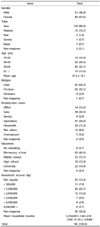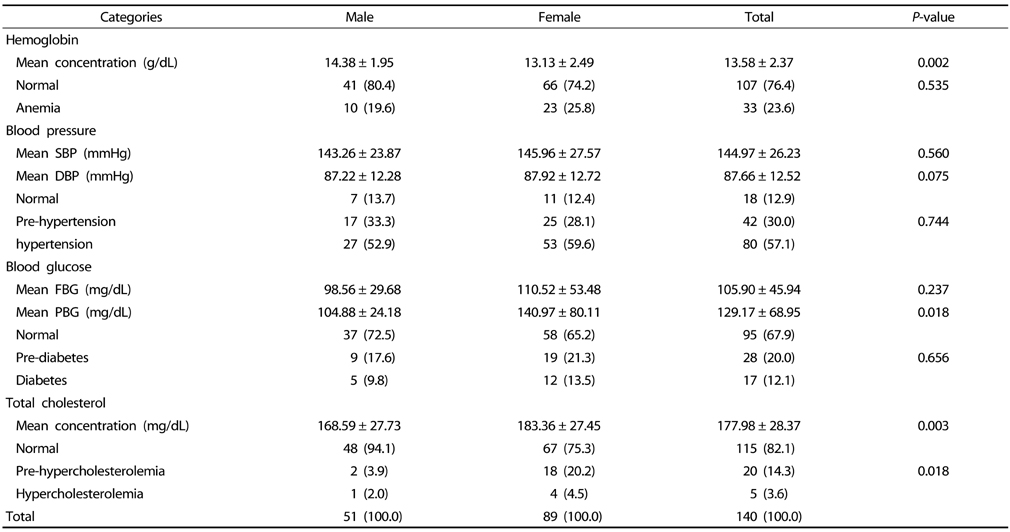2. NCD Risk Factor Collaboration (NCD-RisC). Trends in adult body-mass index in 200 countries from 1975 to 2014: a pooled analysis of 1698 population-based measurement studies with 19·2 million participants. Lancet. 2016; 387:1337–1396.
3. Usfar AA, Agnew P, Juniwaty KS, Howell F. The existence of double-burden of malnutrition in the same households in Eastern Indonesia: analysis using global vs. alternative Asian BMI cut-off points [Internet]. Jakarta: Secretariat of the National Team for the Acceleration of Poverty Reduction (TNP2K);2013. cited 2017 November 1. Available from:
http://www.smeru.or.id/cpsp/Paper,%20Abstact,%20CV/0201_AvitaUsfar-abstract.pdf.
4. Rachmi CN, Li M, Alison Baur L. Overweight and obesity in Indonesia: prevalence and risk factors-a literature review. Public Health. 2017; 147:20–29.

5. United Nations System Standing Committee on Nutrition (UNSCN). Report of the world nutrition situation: progress in nutrition [Internet]. Geneva: UNSCN Secretariat;2010. cited 2017 October 15. Available from:
https://www.unscn.org/files/Publications/RWNS6/html/.
7. Janus ED, Postiglione A, Singh RB, Lewis B. Council on Arteriosclerosis of the International Society and Federation of Cardiology. The modernization of Asia. Implications for coronary heart disease. Circulation. 1996; 94:2671–2673.
8. Soewondo P, Purnamasari D, Oemardi M, Waspadji S, Soegondo S. Prevalence of metabolic syndrome using NCEP/ATP III criteria in Jakarta, Indonesia: the Jakarta primary non-communicable disease risk factors surveillance 2006. Acta Med Indones. 2010; 42:199–203.
9. World Health Organization Western Pacific Region. IASO International Association for the Study of Obesity. International Obesity TaskForce. The Asian-Pacific perspective: redefining obesity and its treatment [Internet]. Balmain: Health Communications Australia Pty Limited;2000. cited 2017 October 17. Available from:
http://iris.wpro.who.int/bitstream/handle/10665.1/5379/0957708211_eng.pdf.
12. Chung KH, Shin KO, Yoon JA, Choi KS. Study on the obesity and nutrition status of housewives in Seoul and Kyunggi area. Nutr Res Pract. 2011; 5:140–149.

14. Holzen HV, Arsana L. Food of Indonesia: delicious recipes from Bali, Java and the Spice Islands. Vermont: Tuttle Publishing;2015. p. 8–10.
15. Susiloretni KA. Sunarto. Compilation of studies related to food consumption, physical exercise, healthy lifestyle, and nutritional status conducted in Indonesia between 2000-2010: age group adult age 20-54 years. Research report [Internet]. Semarang: Health Polytechnic of Semarang;2010. cited 2017 October 15. Available from:
http://www.danonenutrindo.org/research_reports.php.
19. Baksh R, Yustika AE. Sugarcane farmers in east Java: institutional arrangement perspective. J Indones Appl Econ. 2008; 2:43–56.
20. International Diabetes Federation (IDF). The IDF consensus worldwide definition of the metabolic syndrome [Internet]. Belgium: International Diabetes Federation;2006. cited 2017 October 15. Available from:
http://www.pitt.edu/~super1/Metabolic/IDF1.pdf.
22. Liu Y, Tong G, Tong W, Lu L, Qin X. Can body mass index, waist circumference, waist-hip ratio and waist-height ratio predict the presence of multiple metabolic risk factors in Chinese subjects? BMC Public Health. 2011; 11:35.

23. Hastuti J, Kagawa M, Byrne NM, Hills AP. Determination of new anthropometric cut-off values for obesity screening in Indonesian adults. Asia Pac J Clin Nutr. 2017; 26:650–656.
24. Lee KW. The development of the Korean dietary pattern score (KDPS) and its application [master's thesis]. Seoul: Ewha Womans University;2010.
25. Lee BK, Lee JH. Evaluation of dietary variety by body mass index, waist circumference, and exercise habits in female university students. Korean J Food Nutr. 2010; 23:570–581.
26. Bae YJ. Evaluation of nutrient intake and anthropometric parameters related to obesity in Korean female adolescents according to dietary diversity score: from the Korean National Health and Nutrition Examination Surveys, 2007-2009. Korean J Community Nutr. 2012; 17:419–428.

27. Kwon YS, Kim YS. Assessment on dietary diversity according to Korean dietary pattern score of Korean adolescents and children: using 2007-2013 Korea National Health and Nutrition Examination Survey(KNHANES) data. Korean J Food Cook. 2015; 31:660–675.

30. Beutler E, Waalen J. The definition of anemia: what is the lower limit of normal of the blood hemoglobin concentration? Blood. 2006; 107:1747–1750.

35. Willudjeng LK, Purwani SK, Martiana T, Widjiartini W, Putro G. Profil kesehatan kerja nelayan di kota pekalongan dan kabupaten Lombok Timur. Bul Penelit Sist Kesehat. 2004; 7:14–30.
36. Samsudin M. Hubungan kadar plumbum (Pb) dalam darah dengan nilai FT4 pada kelompok wanita usia subur (WUS) risiko terena paparan Pb di daerah perkotaan [master's tesis]. Yogyakarta: Universitas Gadjah Mada;2007.
37. Wibowo Y, Sutrisna B, Hardinsyah H, Djuwita R, Korib MM, Syafiq A, Tilden A, Najib M. Relationship between intra-household food distribution and coexistence of dual forms of malnutrition. Nutr Res Pract. 2015; 9:174–179.

39. Saibul N, Shariff ZM, Lin KG, Kandiah M, Ghani NA, Rahman HA. Food variety score is associated with dual burden of malnutrition in Orang Asli (Malaysian indigenous peoples) households: implications for health promotion. Asia Pac J Clin Nutr. 2009; 18:412–422.
40. Setiati S, Harimurti K, Dewiasty E, Istanti R, Mupangati YM, Ngestiningsih D, Purwoko Y, Aryana IS, Kuswardhani RT, Pramantara ID, Apandi M, Dwipa L, Budiningsih F, Dinda R, Widajanti N, Siburian P, Sunarti S, Umar S, Jim E, Junaidi-Ar . Profile of food and nutrient intake among Indonesian elderly population and factors associated with energy intake: a multi-centre study. Acta Med Indones. 2013; 45:265–274.
42. Miller WL, Crabtree BF, Evans DK. Exploratory study of the relationship between hypertension and diet diversity among Saba Islanders. Public Health Rep. 1992; 107:426–432.
44. Wang SB, Cho YC. Body mass index and subsequent risk of hypertension, hyperglycemia and hypercholesterolemia in health checkup examinees. J Korea Acad Ind Coop Soc. 2011; 12:2677–2684.

45. Nurhayati . Recommended alternative daily intake of fruits and vegetables for Indonesian elderly. Health Sci Indones. 2014; 1:30–34.
46. Azadbakht L, Mirmiran P, Esmaillzadeh A, Azizi F. Dietary diversity score and cardiovascular risk factors in Tehranian adults. Public Health Nutr. 2006; 9:728–736.










 PDF
PDF ePub
ePub Citation
Citation Print
Print







 XML Download
XML Download